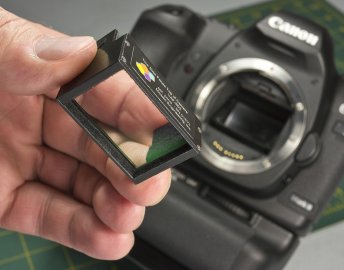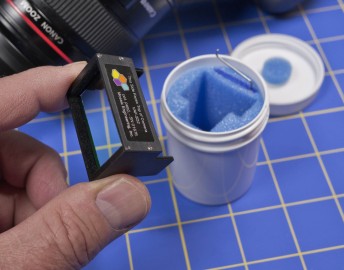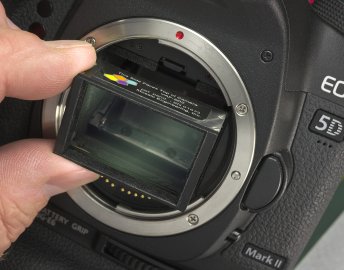It’s not very often a product comes to market that seems like it’s nothing short of magic. At first glance, the VAF-5D2 Optical Anti-Aliasing Filter by Mosaic Engineering is such a product. I was skeptical at first with this $385 product, but after reading some positive feedback from Philip Bloom at its initial prototype stage, I knew this product was for real.
 It took longer than expected to arrive here at out facility (ordered back in August, and arrived here mid-November), but the wait was worth it. After some initial A/B testing with and without the filter, I’m thrilled with the results. The science behind this device is amazing, and it works, and it works extremely well.
It took longer than expected to arrive here at out facility (ordered back in August, and arrived here mid-November), but the wait was worth it. After some initial A/B testing with and without the filter, I’m thrilled with the results. The science behind this device is amazing, and it works, and it works extremely well.
Looking around the facility, I tried to find something I could shoot right away to really put this filter to the test. After going through all the rooms in the facility, I stumbled on something that was perfect: an Ampeg bass amp cabinet. The interwoven silver mesh covering of the cabinet creates all the aliasing, moiré and rainbow effects you could ever hate. The aliasing is so bad in fact that it causes the Canon encoder to pulsate on the aliasing portions. Without the VAF-5D2 filter, such footage would be completely useless. With the filter, it’s as clean as a whistle. I’m still shocked at how well this filter works, especially since looking at the filter with the naked eye doesn’t reveal any optical characteristics that make the filter work (it just looks like a clean, clear piece of glass).
 I shot the footage handheld to further amplify the aliasing problems with the native 5D Mk II. I also pushed the camera in and out so that the focal plane (where aliasing is most present) would also be more noticeable. The first comparison was shot at an angle so that the focal plane was most obvious (causing DOF blur behind and in front of the focal plane). The second comparison is flat against the amp cabinet so that the focal plane covers the entire face, causing an aliasing nightmare, again pushing in and out to see how the aliasing reacts.
I shot the footage handheld to further amplify the aliasing problems with the native 5D Mk II. I also pushed the camera in and out so that the focal plane (where aliasing is most present) would also be more noticeable. The first comparison was shot at an angle so that the focal plane was most obvious (causing DOF blur behind and in front of the focal plane). The second comparison is flat against the amp cabinet so that the focal plane covers the entire face, causing an aliasing nightmare, again pushing in and out to see how the aliasing reacts.
I used our Canon 50mm f/1.2L at f/2 to keep the lens sharp. I also shot at 160 ISO for least sensor noise, and 1/50th shutter speed to replicate what we normally shoot at.
Viewing at full 1080 HD resolution (the is important to really see the comparisons), you can easily see the difference in quality. With the VAF-5D2 installed, the image is completely clean of any aliasing or moiré effects. It’s like having a new camera by Canon! Converting this test footage to ProRes and outputting to our HD monitors (CRT and LED) REALLY shows off the hideousness of the aliasing without the filter installed, and the clarity of the footage with the filter installed. Just amazing.
Installation and removal of the VAF-5D2 is quick and easy. They give you a little puller tool to remove it from the sensor housing area.
 The VAF-5D2 does have some drawbacks (crazy, I know). For one, your focus distance changes slightly, which wont be a big deal for many, including myself. Some wider lenses, 24mm and below may causing some vignetting or softness at the corners. I found that I did get some slight vignetting at the corners with my 24mm f/1.4L II, and my 16-35mm f/2.8L II between 16-24mm. Our 35mm f/1.4L seemed fine, as well as anything at higher lengths. Personally, the vignetting is minimal and I’d rather fix that in post (very easy) with no aliasing and moiré than the other way around. Also, if you take still photos with your 5D Mk II, you need to remove the VAF-5D2 for optimal still photo quality (only takes a few seconds to remove it).
The VAF-5D2 does have some drawbacks (crazy, I know). For one, your focus distance changes slightly, which wont be a big deal for many, including myself. Some wider lenses, 24mm and below may causing some vignetting or softness at the corners. I found that I did get some slight vignetting at the corners with my 24mm f/1.4L II, and my 16-35mm f/2.8L II between 16-24mm. Our 35mm f/1.4L seemed fine, as well as anything at higher lengths. Personally, the vignetting is minimal and I’d rather fix that in post (very easy) with no aliasing and moiré than the other way around. Also, if you take still photos with your 5D Mk II, you need to remove the VAF-5D2 for optimal still photo quality (only takes a few seconds to remove it).
Okay, well, so much for a short “first look” review. I love this new filter so much that I guess I went into full review mode. At any rate, the sooner you order your VAF-5D2, the better as it took mine almost three months to get here. But again, well worth the wait. For a three-year-old camera, I feel like I have a new camera again. I can’t recommend the VAF-5D2 enough.
Check out the comparison video we shot here on Vimeo:
All product still photos on this blog post from Mosaic Engineering’s website:
http://www.mosaicengineering.com/products/vaf-5d2.html
Share this post
Article © OneRiver Media, including applicable photographs. All rights reserved. Article and its contents shall not be copied or reprinted without the expressed written approval of OneRiver Media.
FCC Disclaimer - Links from this article might go to affiliate links to B&H and/or Amazon (not much different than the ads you see in YouTube ads, but more focused). Visiting these links (or buying products from the links) cost you nothing additional and may in turn help us pay for the cost of hosting these free articles we write. These articles take an enormous amount of time (in most cases, weeks and months) to research, draft, write, edit, rewrite, and shoot custom photography/video for. In no way do these affiliate links cover the cost of all of that, so any help these links can provide is a huge help to us to continue to offer free content to our readers.

Comments 14
Its great that it addresses the moire. But repeated use also makes the camera vulnerable to dust and dirt incursion. To bad it just cant stay in there all the time. 😀
Author
If uncared for, maybe so that it might be prone to added dust, but if there’s one thing I’m OCD in is the care of my cameras. 😉 If anything, it’s only a few seconds to remove the filter when not in use, so there wouldn’t be any difference in dust management when shooting video. I still believe the positives outweigh the negatives.
hello I have been reading and watching your review of the Mosiac filter. I really appreciate you taking the time to do the review and post footage. I also read many times to watch the video in HD 1080. I did that and it does look much better. My question is why doesn’t the aliasing/moire go away in the smaller frame size? In fact I don’t see the shots with the filter being any better at all. If the filter doesn’t help with a compressed video then is it really helping? A lot of videos these days aren’t viewed in “1080 HD”. I’m also noticing a large brownish diagonal line on the speaker mesh?
I’m really not trying to be a pain in the ass. I’m wanting to believe this filter works but I’m not sold yet. I know you don’t work for Mosiac and I’m sure you are as desperate as I am to get away from the 5Dmk2 moire mess.
Thanks for sharing.
Tom if you ever change a lens you are risking dust in the camera. It’s pretty easy to clean the sensor.
Author
This is actually a good question. It’s true that some scaled/down-rezzed versions of the video do in fact exhibit the same moiré and aliasing in both the filtered and non-filtered footage. Unfortunately, this is mostly because of the down-rez resampling algorithm that is used to either down-rez the video in real-time (as in the case of Vimeo or YouTube real-time playback), or the type of rendering quality that would be done in a more quality-driven conversion. The former (realtime down rez) typically uses a “nearest neighbor” or “line-skipping” approach, as this uses the lowest amount of CPU power. The downfall however, is that it’s not very accurate and is prone to aliasing in its own right (causing aliasing in video that didn’t originally have it). This is exactly the same way current DSLRs reduce the the huge sensor resolution down to 1080 or 720 HD. Likewise, what you’re seeing in Vimeo, when not viewed in 1080 HD, is exactly that… a real-time line-skipping conversion that adds aliasing on real-time playback, not because of how the footage was shoot, but because the real-time calculation throws out vertical and horizontal data without properly merging them together, as what is otherwise typically done in the latter (down-rez rendering) type of scaling (like you’d do in After Effects). The problem with the latter approach is that it uses up much more CPU power and is slower to process. If you were to properly scale the video from 1080 HD down to 480 SD using something like After Effects, then there would be no aliasing or moiré at 480 SD playback. So the key really is to shoot it as best as possible at the highest resolution possible. If I knew my deployment format was 720 HD, I’d properly down-rez a master file to 720 HD, then upload that.
Thanks Marco- I had a feeling you were going to say it’s mathematical. So can you do some math and render another video that plays on Vimeo in a smaller frame? : )
Please?
Does Vimeo allow videos to be uploaded without real time down rezed? I’ll have to look at their settings again.
Thanks again for sharing this.
Author
Glad to be of help! If I can make some time this week, I’ll transcode and upload 720 HD and 480 SD versions as well.
Unfortunately there’s really no way around the down-rez thing, especially if someone had a screen that was smaller than 1920×1080 (like 1080×960 or something like that) and they would have to view it smaller than 1080 HD. Is this the issue you are having right now? Is your computer screen smaller than 1920×1080 and it’s forcing your playback at a smaller resolution?
No monitor size is not an issue. Loading some videos at larger sizes can take longer and playback can suffer. I don’t need full screen video when my laptop is 2 feet away. My 30inch monitor is fine. iPhone-different story.
I think I can explain this. What’s going on here is the spatial equivalent of downsampling an audio signal. For example…
If you sample at 196.4 kHz, then downsample to 44.1 kHz to make a CD, signal components higher than 22.05 kHz will be “imaged” into the audio band. Before downsampling, you must filter the sampled data to a bandwidth appropriate for the final sampling rate.
The 5D2 already has an anti-aliasing filter. But it’s designed for a 4k by 6k sensor. Reducing the scan to 1080 lines requires downsampling the sensor’s data. If the samples aren’t low-pass-filtered appropriately, there will be “beats” or moire in areas of fine detail, the visual equivalent of audio aliasing.
Apparently, this filter does what the camera’s software does not. Those who take only still photos don’t need it.
Im not sure your video does the product justice. On close viewing I see unacceptable moire in both the WITH and WITHOUT shots of the speaker grill. Are you not seeing this as well? By your enthusiastic review I thought it would be eliminated. It still looks very bad to me. FYI I own the 5D and just accept this as one of its limitations. I wouldnt pay almost $400 for what I see it not doing in your attached video.
Author
Tom, are you viewing on a fully capable 1920×1080 raster display at *full* resolution, and fully expanded on Vimeo playback? Without viewing on such a monitor, you will NOT see the difference you’re describing. If you’re viewing at anything less than 1080 HD, you will not see a big difference. The difference is huge actually. In fact, comparing the anti-aliasing from a normal 1080 HD video camera, like our EX1, the results of this with the 5D2 are just as good, if not better than our EX1.
Thanks Marco. That was the problem. Upon viewing full frame 1080 it is subtler. Although it does bring up an interesting issue when you are doing web stuff that is not meant to be played in the manner. 😀
Author
No problem. As mentioned above, you need to dial in what deployment resolution you’re targeting, then down-scale for that via rendering. Any real-time scaling, whether it be Vimeo, YouTube, your computer screen, FCP Canvas window, or whatever, is going to have inherent aliasing on real-time playback, which is what you initially saw. I’m planning on uploading a 720 HD and 480 SD samples of the same video as well as soon as time permits.
Do you think the filter will fix the moire problem that I am having shooting nylon bags in outdoor settings. I am debating if this is worth the $400 or just deal with the output as it is.. the format will only be web use.
http://vimeo.com/33203153
Any advice would be helpful about the moire issue or any way to improve these bag review videos.. this is only the 3rd video that I have shot ever. THANKS.
Author
Nice video! And only your third one ever? You’re off to a great start! You’ve been doing your homework! 😉
Cool backpack and I like the guy’s jacket for that matter. The VAF-5D2 filter would definitely help the footage. You can really see the straps dancing at 2:16-2:18. Would all be gone for sure.